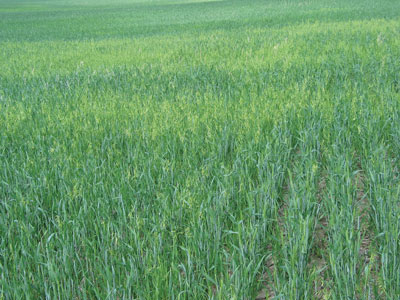
Features
Agronomy
Cereals
Fine-tuning wheat agronomics
Input prices are high: how can growers change their agronomic practices to address ever rising input costs?
May 1, 2009 By Top Crop Manager
Input prices are high: how can growers change their agronomic practices to address ever rising input costs? Fine-tuning to take better advantage of new technologies is likely better than any drastic changes. “We’re going to try to be up on our agronomics to make sure an unexpected problem doesn’t cut into yield, but we’re not going to do anything too different than what we have always done,” says Tim Kubinec, who farms with his son Ryan near Westlock, Alberta. “We’ve always managed for high yields, so that’s what we will continue to do.”
 |
| Pay attention to agronomics to add extra bushels to the bin. |
At Lacombe, Alberta, crop consultant Jay Bruggencate with Demeter Solutions has a similar approach, and is working with his clients to fine-tune their wheat production. “I don’t see any drastic changes to the overall crop plans. There are a few technologies that we might take a more serious look at, but the basics remain the same,” explains Bruggencate.
Both Bruggencate and Kubinec say they will take a close look at their fertility plans to see if more yield can be squeezed out of the land. With high fertilizer prices that means taking a close look at soil moisture conditions and assessing yield targets.
Kubinec has always pushed for high yield, targeting around 80 bu/ac for his CPS wheat, and around 60 bu/ac for CWRS wheat. “We’ve hit 100 with CPS, and quite often get 60 bushels for HRS wheat. We’re in a pretty good area so we can push our yields,” says Kubinec.
Soil testing is a part of the Kubinecs’ plans. As an example of the types of fertilizer rates that Kubinec is considering, he cites a soil test recommendation from one of his fields. For excellent growing conditions with a yield target of 62 bu/ac of HRS, his soil test recommendations call for 93N-46P-68K-0S. While the Kubinecs are still finalizing their application rates, he says that they will be “pushing a pretty good rate.”
Bruggencate says that he and his clients are also taking a close look at fertilizer recommendations. One area that he says his clients are becoming more interested in is variable rate N-P-K-S fertilizer application. They may also experiment with variable rate seeding rates within fields as well. Variable rate fungicide application is also a possibility.
While the technology has been around for some years, the agronomics of where to vary application rates have lagged. Today, Bruggencate is using Farmer’s Edge Precision Consulting, which develops prescription variable rates for different management zones in the field. He believes that Farmer’s Edge has the right agronomic approach, and will be working with some of his clients to assess the technology. “A few of my clients are going down that road, and in my opinion, variable rate application is the next big leap, especially when you look at how variable the land is in central Alberta,” says Bruggencate.
In-crop yield protectors
Getting the crop off to a fast, clean start will also be important this spring. Good pre-seed weed burndown, using high-quality seed, and timely planting into a good seedbed with accurate seed placement are all basics that can return extra bushels in any year.
Crop scouting also remains important. Kubinec and Bruggencate say they plan on paying extra attention to disease scouting and will use fungicides if warranted. Stripe rust, tan spot and septoria disease will be closely monitored. “When wheat prices are high, a fungicide application almost becomes a standard treatment here in central Alberta,” says Bruggencate.
Weed control is another area that can be fine-tuned. Along with a good pre-seed burndown, scouting for weeds, identifying threats and spraying weeds early can protect a grower’s time, effort and money.
Bruggencate says that this might be the year to really go after some weed problems that have been lingering: wild oat or thistle problems, for example.
Saving yield by eliminating competition from weeds, insect pests and diseases is likely one of the best areas to target input dollars. But using them wisely, by, for example, controlling weeds early, or taking insects out when they hit economic thresholds, is even more important. “Everest herbicide has a great reputation among growers because it is the only wheat herbicide that controls wild oats, green foxtail and other key grass and broadleaf weeds flush after flush. That means you can go in early, even at the one- to two-leaf stage, to protect yield and not have to worry about later germinating weeds competing with the crop,” says Arysta LifeScience’s Tony Zatylny at Calgary, Alberta. “In fact, research from North Dakota shows that if you wait to spray later, significant yield loss can occur in wheat.”
In the end, sticking with tried-and-true agronomics that establish a high yield potential, and then ensuring that weeds, insects or diseases do not steal yield from the bottom line is the best approach. “There isn’t any new magic bullet that will give much higher returns, but there are a few areas where extra attention can help. And every extra bushel produced at today’s prices can make a big difference in returns,” says Bruggencate.